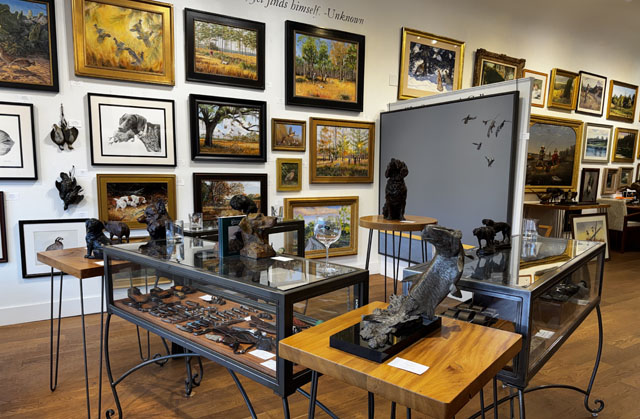Lowcountry Love Stories You’ve Never Heard
04 Jan 2018
From Poe to Rhett and Scarlett, murderous duos to pirates, the historical tales of Charleston’s great loves are more riveting than any romance novel you’ve read before
By SUZANNAH SMITH MILES

With Valentine’s Day in the offing, here’s a look back at a few loves of the famous (and infamous) in Charleston history. Some romances led to happily-ever-after wedded bliss—others straight to the gallows. Which ones you ask? Read on to find out.
It was “many and many” a year ago (1849 to be exact) that Edgar Allan Poe wrote his famous poem, “Annabel Lee,” about lost love in a kingdom by the sea. “I was a child and she was a child,” penned Poe of the two who “loved with a love that was more than love.” Of course, with true Poe-etic morbidity, the wind blew out of a cloud, “chilling and killing” poor Annabel Lee.
Many Poe scholars say Annabel Lee was Poe’s wife, Virginia Eliza Clemm—who was also his first-cousin and a 13 year old when they married in 1835. Poe was 27. Virginia died of tuberculosis only twelve years later.
Others believe Annabel Lee was someone Poe met as a young soldier stationed at Fort Moultrie in 1827—and that the “kingdom by the sea” was either Charleston or Sullivan’s Island. Some go so far as to surmise she was a daughter of Charleston physician, Dr. Edmund Ravenel, who had befriended Poe during his time on the island. The main character in Poe’s book of lost pirate treasure, The Gold Bug, is purportedly based on Dr. Ravenel.
Dr. Ravenel did have female children but none statistically fit the bill for being old enough (or dead enough) to have been in Poe’s sphere while he was in Charleston. One daughter, Theodosia Ravenel, did meet an untimely death when she drowned in the surf at Sullivan’s Island on July 14, 1848. She was only 11 years old. Since the poem was composed in May 1849, the timing is right—except that Theodosia wasn’t even born when Poe was on the island in 1828.
No love story is probably more fabled than Scarlett and Rhett in Gone With The Wind. While those star-crossed lovers were fictional, it is said that Margaret Mitchell based Rhett Butler’s character on a very real Charlestonian, the dashingly good-looking George Alfred Trenholm. A partner in a lucrative import-export business, during the Civil War Trenholm was a major bankroller of the blockade-runners who brought manufactured goods into Charleston and moved Southern cotton out. He also became Secretary of the Treasury for the Confederacy.
Blockading (and good looks) are perhaps the only things Trenholm and the fictional Butler had in common. Trenholm obviously very much “gave a damn” about his wife, Anna Helen Holmes. The couple lived in a majestic home on Rutledge Avenue where, in happily married bliss, they produced no less than 13 children. The former Trenholm mansion is the Regency-style, multi-columned and ultimately romantic building known today as Ashley Hall School.
The story of John and Lavinia Fisher is one of hearts and scaffold. Legend states that in 1819 from their inn on the main road out of Charleston called the Six Mile House, this young couple brutally murdered their guests in order to steal from them. Convicted of murder, Lavinia supposedly stood on the gallows in her wedding dress and yelled defiantly, “If you have a message for the devil give it to me and I will carry it!”
In truth, the Fishers were likely only guilty of highway robbery. As for murder, the two vehemently denied their guilt to the very end. Also doubtful is Lavinia’s defiant last words about meeting the devil in person. Both she and John had spent their last weeks on earth praying with ministers, having petitioned the court for a delay in the execution date to give them an “opportunity for repentance” and to prepare their souls for the afterlife.
The hanging of this notorious couple took place at the Charleston jail on February 19, 1820, an event reported in detail by newspapers nationally. Said one reporter, “Fisher protested his innocence of the crime to the last… He met his fate with great firmness. His wife… appeared to be impressed with a belief, to the last moment, that she would be pardoned. A little past 2 o’clock, the husband and wife embraced each other upon the platform for the last time in this world, when the fatal signal was given—the drop fell—and they were launched into eternity.”
Stories about the pirate Anne Bonny still bring thrills—along with unanswered questions about her love life. We know she was living in Charles Town when she ran off to sea with the young sailor John Bonny while still in her teens. She afterwards took up pirating with the flamboyant Calico Jack Rackham, mixing up at the same time with the other “lady” pirate, Mary Reade. She apparently liked a bloody sea-fight and did so wearing men’s clothes. Yet when she was finally caught and tried for piracy in 1720, it was her femininity—her “belly”—that saved her life. It simply wasn’t okay to hang a pregnant pirate.
Legends abound about her life afterwards. One of the most persistent stories is that after she gave up pirating she returned to Charleston, living in isolation as the captive mistress of another pirate, Captain Robert Fenwick of the Red Sea Men. Fenwick purportedly held her in either a tower or a dungeon (take your pick) at Fenwick Hall on the Stono, where he ran a smuggling operation through hidden tunnels that led to the river.
Right. Except Fenwick Hall wasn’t owned by Robert Fenwick (who died in 1726) but rather was built by his brother, John, in 1730. It is true that Robert Fenwick had arrived in Charles Town in 1692 on the privateer “Loyall Jamaica” and probably had been involved with so-called “legal” piracy-cum-privateering. Yet he afterwards lived a stellar, rather faultless life as a Congregationalist elder and member of the assembly at his plantation on the Wando River (a section of Park West today). His wife, Sarah, was the daughter of one of the wealthiest men in the colony, Theophilus Patey, who owned the plantation we know today as Boone Hall. The owner of Fenwick Hall, John Fenwick, had come to Carolina straight from England and was happily married to Elizabeth Gibbes, the daughter of Governor (and Chief Justice) Robert Gibbes, of Barbados and later, Charles Town.
So how did the legend of Anne Bonny and Fenwick Hall come about? For this we thank the late, great Charleston writer and storyteller, Herbert Ravenel Sass. In a newspaper interview he admitted fusing the two stories—the legend of the underground tunnel at Fenwick Castle and Anne Bonny’s escapades—into one story published in the November 1, 1946 edition of “Saturday Evening Post.” This later became the 1951 swashbuckling movie, Anne of the Indies, starring Jean Roberts and voila! The legend was born.
And then there’s the story of the pirate who lived in the windswept house at the far northern end of Sullivan’s Island with his beautiful wife who, alas, became too friendly with a handsome young lieutenant from Fort Moultrie. When the two were found locked in an embrace, the pirate dispatched the lieutenant with one shot, then took his wife to Breach Inlet at low tide and tied her to a stake. Presumably from the veranda, while sipping a toddy, he watched the tide slowly come in until his wife’s cries, growing weaker as they mingled with the mewing of the gulls, were heard no more.
Alas and alack, hearts and flowers, indeed. Perhaps the best we can do is follow the advice of songwriter Stephen Sills: If you can’t be with the one you love, then love the one you're with.












